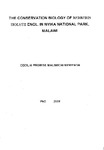THE CONSERVATION BIOLOGY OF BERBERIS HOLSTII ENGL. IN NYIKA NATIONAL PARK, MALAWI
| dc.contributor.author | NYIRENDA, CECILIA PROMISE MALIWICHI | |
| dc.contributor.other | School of Biological and Marine Sciences | en_US |
| dc.date.accessioned | 2013-09-10T10:17:13Z | |
| dc.date.available | 2013-09-10T10:17:13Z | |
| dc.date.issued | 2008 | |
| dc.identifier | NOT AVAILABLE | en_US |
| dc.identifier.uri | http://hdl.handle.net/10026.1/1625 | |
| dc.description.abstract |
Biological resources are particularly important in resource-limited countries where utilisation demands challenge conservation efforts. The study focussed on Berberis holstii, a plant resource on high demand in northern Malawi restricted to Nyika National Park. The uses, distribution, habitat characteristics, demography and seed germination requirements of this important species were investigated. Uses were investigated by means of ethnobotanical interviews. The species distribution in the park was mapped employing GIS. Habitats were characterised employing multivariate methods implemented in the programmes PC-ORD and PRIMER. Demographic studies employed matrix projections to characterise representative populations. Finally, laboratory germination trials allowed determination of light, cold stratification and temperature requirements for seed germination. Forty-seven uses were documented. Of these, thirty were medicinal and the rest for income generation. The most common uses included infusion for coughs, malaria, stomachache, sexually transmitted infections and pneumonia. Because roots are employed, whole plants are dug out. This lead to the extinction of five of the recorded 94 sites. Fire periodically kills the aerial part of plants, which then tend to recover through resprouting. The species is restricted to high altitude, open areas on sandy/loamy soils. Despite harvesting and fire, demographic projections showed positive population growth. Population growth rate is more sensitive to mortality of late juvenile stages and early adult stages than it is to demographic transitions and contributions by other stage classes. Germination was higher when seeds were stored for one year, had a prechilling treatment (cold stratification) and were germinated under light at -20°C. Seeds did not lose viability during two years of storage raising prospects for their artificial storage. The study provides important information for the conservation and management of this important African endemic. It highlights some of the difficulties confronted in projecting the population dynamics of species with sporadic simultaneous recruitment and tests the ability of a recently proposed model to determine germination requirements. In a wider context, the study shows that a combination of methodological approaches (ethnobotany, biogeography, demography and germination) allows a more complete understanding of the evolutionary, ecological and social factors that must be taken into account in the conservation of individual species. | en_US |
| dc.language.iso | en | en_US |
| dc.publisher | University of Plymouth | en_US |
| dc.title | THE CONSERVATION BIOLOGY OF BERBERIS HOLSTII ENGL. IN NYIKA NATIONAL PARK, MALAWI | en_US |
| dc.type | Thesis | |
| plymouth.version | Full version | en_US |
| dc.identifier.doi | http://dx.doi.org/10.24382/4699 | |
| dc.identifier.doi | http://dx.doi.org/10.24382/4699 |
Files in this item
This item appears in the following Collection(s)
-
01 Research Theses Main Collection
Research Theses Main


